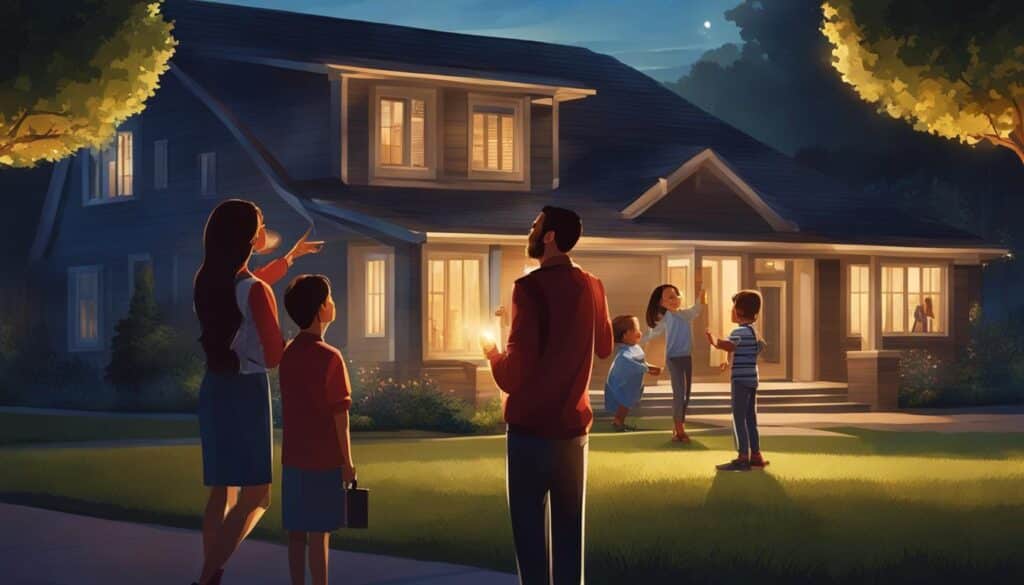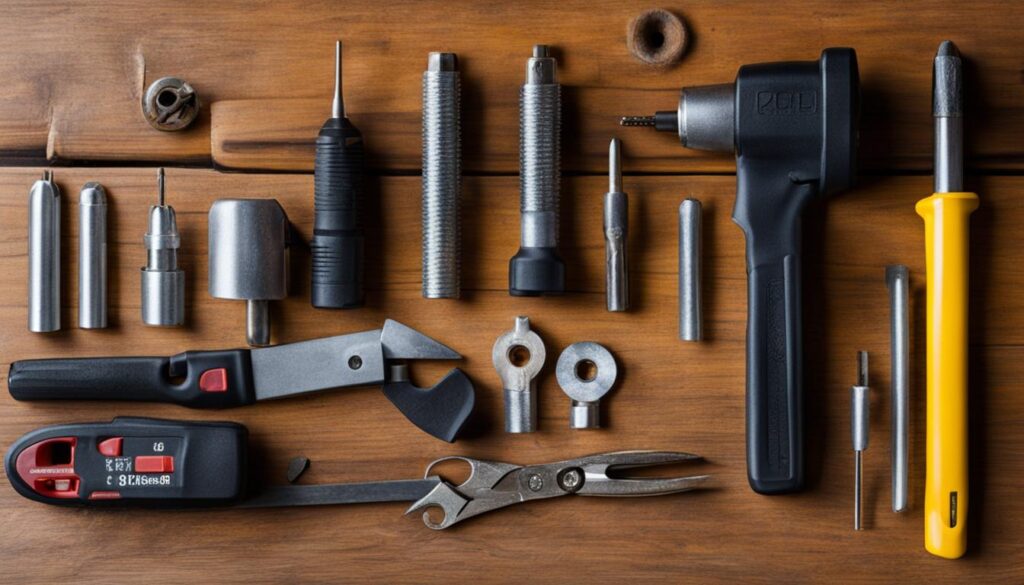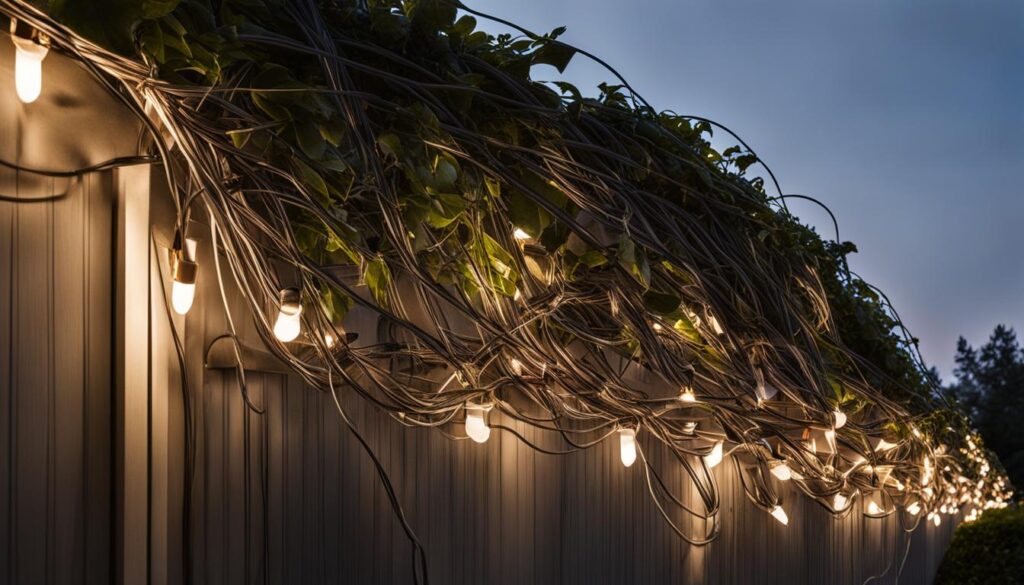Installing outdoor lighting can dramatically transform the look and feel of your home’s exterior, providing additional safety, functionality, and a welcoming ambiance. Whether you’re illuminating walkways, accentuating architectural details, or creating a comfortable patio setting, this step-by-step outdoor lighting installation guide makes it easier than ever to enhance your property.
While some projects may require the expertise of a professional electrician, you’ll find that with a little planning and a DIY mindset, you can achieve a stunning and functional lighting design for your outdoor space. Just follow this detailed guide on how to install outdoor lighting, ensuring you have a reliable power source and adhering to proper safety guidelines.
Key Takeaways
- Outdoor lighting installation improves safety, functionality, and aesthetic appeal.
- Planning and preparation are crucial for successful outdoor lighting installation.
- Select lighting styles and fixtures that complement your home and outdoor decor.
- Ensure all tools, materials, and safety guidelines are in place before starting.
- When in doubt, consult or hire a professional electrician for complex lighting projects.
Embracing the Beauty of Outdoor Lighting
Outdoor lighting not only enhances security and functionality but also brings out the beauty of your home, making it stand out after dusk. To amplify your home’s curb appeal, it’s crucial to strategically plan and design the integration of exterior lighting. By doing so, you can magnify focal points and ensure an even distribution of light throughout your yard or garden.
When devising your outdoor lighting installation, consider these essential tips:
- Determine the best type of lighting for each specific area and purpose
- Calculate the appropriate wattage to achieve optimal brightness and energy efficiency
- Experiment with a blend of lighting styles to craft a unique, harmonious ambiance
- Use timers and dimmers to save energy and complement varying moods
Maximizing the aesthetic appeal of your outdoor lighting installation involves a balance between functionality, safety, and visual impact. The most effective approach is to layer different types of lights, providing a dynamic fusion of illumination that makes your outdoor space feel warm and inviting.
“Outdoor lighting should not only be striking but purposeful, illuminating the way and embellishing your outdoor environment.”
The goal is to make your home and landscape absolutely glow at night, creating an unforgettable impression on those who see it. By highlighting architectural elements, guiding walkways, and accenting garden features, you can craft a truly enchanting atmosphere.
| Layer | Lighting Type | Function |
|---|---|---|
| 1 | Ambient | Provides general illumination for navigation and visibility |
| 2 | Task | Helps to accomplish specific tasks, such as grilling or reading |
| 3 | Accent | Highlights architectural and landscape features, increasing depth and interest |
| 4 | Decorative | Adds character and charm to your outdoor space |
Ultimately, striking a balance between practicality and the outdoor lighting aesthetic will help you establish a captivating and functional external environment. Be sure to avoid common mistakes, like glaring lights and over-illumination, as they can detract from the overall atmosphere. By thoughtfully implementing the above tips and techniques, you’ll achieve an exceptional outdoor lighting design that perfectly complements your home.
Choosing Your Outdoor Lighting Style
When you’re getting ready to enhance your outdoor space with various lighting options, it’s essential to consider the style that suits your needs and preferences. In this section, we’ll discuss different lighting types, how to strike a balance between aesthetics and functionality and how to match your chosen lights with your existing outdoor decor.

Understanding Different Lighting Types
As you start exploring your options for choosing outdoor lighting, you’ll come across various types of fixtures suited for specific purposes. Some common types include:
- Pathway lights: These provide soft illumination for walkways and garden paths, guiding guests safely through your outdoor space.
- Spotlights: Bright, focused lights designed to highlight particular landscape elements, architectural features or artwork.
- Wall mounts: Installed on exterior walls, these lights offer ambient lighting and accent architecture directly adjacent to your home.
Consider the purpose of each lighting element as well as the size and scope of your outdoor space when selecting the right type of fixtures.
Balancing Aesthetics and Functionality
One major factor in choosing outdoor lighting is finding a balance between aesthetics and functionality. Think about how you want your space to look, but also consider the practical reasons for installing lights in specific areas. For instance, you may want to improve safety and visibility along walkways while accentuating focal points like garden statues or water features.
Be sure to select fixtures that serve both decorative and practical purposes, ultimately enhancing your home’s curb appeal and creating a comfortable outdoor environment.
Matching Lights to Your Outdoor Decor
Whether you have a lush garden, a sleek contemporary patio, or a classic, elegant front entrance, your light fixtures should harmonize with your outdoor decor. To achieve this:
- Consider the style of your lighting fixtures, ensuring they complement the overall theme, be it modern, traditional, or farmhouse.
- Pay attention to details like the material of the fixtures. Choices like brass and wrought iron evoke a classic feel, while stainless steel and glass lend a contemporary touch.
- Choose a color that either blends seamlessly with your home’s exterior or boldly stands out as a design feature.
By taking these factors into account, you’ll create a cohesive outdoor lighting scheme that enhances your home’s architecture and elevates your landscaping.
The Preliminaries: Planning Your Outdoor Lighting Setup
Embarking on an outdoor lighting installation project requires careful thought and assessment of your available space and existing features. To ensure a successful installation, consider the following factors and use this outdoor lighting installation checklist as a guide.
- Survey your property and identify key areas requiring illumination.
- Determine the types of lighting fixtures needed to achieve the desired effect.
- Establish a reliable power source for your outdoor lighting system.
- Create a layout indicating the precise placement of each lighting fixture.
- Evaluate additional considerations, such as local building codes and weather conditions.
During the planning stage, it’s vital to analyze the purpose of your outdoor lighting. Some common goals include:
- Emphasizing architectural features or landscape elements.
- Improving visibility for safety.
- Creating an inviting ambiance for outdoor gatherings.
By outlining your objectives, you can determine the ideal fixture types, placement, and power requirements necessary to accomplish that vision.
Power requirements play a significant role in your outdoor lighting installation project, as they dictate the kind of system that will best suit your space. You may need to set up an independent circuit, extend from existing electrical lines, or opt for solar-powered alternatives. Additionally, be sure to consult your local building codes for any specific requirements concerning outdoor lighting systems.
| Power Source | Advantages | Disadvantages |
|---|---|---|
| Independent Circuit | Dedicated power supply, less likely to cause power interruptions to other devices. | Requires professional installation, higher initial cost. |
| Extended Electrical Lines | Utilizes existing power grid, generally less expensive than an independent circuit. | Potential for overloading your home’s electrical system, wiring may involve additional costs. |
| Solar-Powered | Eco-friendly, energy-saving, and easy to install. | Relies on consistent sunlight to recharge, lower brightness levels, and may require additional maintenance. |
Once you’ve established your design objectives and determined the necessary power solutions, take the time to develop a detailed layout plan for your outdoor space. This should include the precise placement of each lighting fixture, their power sources, and the overall aesthetic flow of the illuminated areas. By organizing your plan and adhering to a comprehensive checklist, your outdoor lighting installation project will result in an attractive and functional outdoor space for you and your loved ones to enjoy.
Gathering Your Outdoor Lighting Installation Toolkit
Embarking on a DIY outdoor lighting installation project requires careful planning and preparation. This includes assembling the essential installation tools and selecting the right outdoor light fixtures. Furthermore, adhering to safety guidelines is vital for a successful and secure installation process.

Essential Tools for the Job
Before beginning the installation process, make sure you have all the necessary tools at hand. Here is a list of essential tools you’ll need for a smooth and efficient outdoor lighting installation:
- Wire strippers
- A shovel or trenching tool for digging
- Screwdrivers
- Hammer and stakes
- Level
- Measuring tape
- Markers for temporary placement
- Protective gloves and goggles
Choosing the Right Outdoor Light Fixtures
Selecting appropriate light fixtures plays a crucial role in the overall success of your outdoor lighting project. Consider the following factors when choosing the right fixtures for your space:
- Outdoor lighting type (low-voltage, solar, or line voltage)
- Energy efficiency
- Ease of installation
- Style and design that complements your home’s architecture
- Durability and weather resistance
Pre-Installation Safety Checklist
Ensuring a safe and secure installation process is of utmost importance. Before you begin, review the following pre-installation safety checklist:
- Inspect the installation site for any potential hazards or obstacles
- Ensure all connections are waterproof and use outdoor-rated wiring
- Verify the power source is GFCI-protected
- Gather all necessary protective gear (gloves, goggles, etc.)
- Read the manufacturer’s instructions for each light fixture thoroughly
- Follow local building codes and obtain any required permits
By preparing your toolkit, selecting suitable fixtures, and keeping safety at the forefront of your DIY outdoor lighting installation, you can create a beautiful and inviting outdoor space that enhances the aesthetics and functionality of your home.
Mounting Your Outdoor Lighting Fixtures
Once you have chosen the perfect lighting fixtures and prepared your outdoor space, it is time to make your vision come alive by mounting outdoor lights. Following this outdoor lighting installation tutorial will ensure that your fixtures not only look great but are also adequately supported to withstand weather conditions.
To begin, let’s explore the necessary steps for installing different types of fixtures.
- Path Lights: When installing path lights, you need to dig a trench that is deep enough for the light’s stake. Place the stake in the ground and make sure the light is level. Fill in the trench and compact the soil around the light to keep it securely in place.
- Wall-mounted Lights: For wall-mounted lights, mark the locations where you want to install them on the wall. Drill a hole in each marked location and insert appropriate wall anchors. Align the fixture with the wall anchors and tighten the screws to secure the fixture.
- Spotlights: Spotlights can be mounted on trees or other structures in your yard. Choose a stable mounting location and secure the spotlight using a suitable fastening system. Adjust the angle of the light to highlight the desired focal point.
After mounting your lights, take the time to ensure they are level and plumb. A perfectly aligned fixture will provide optimal illumination and contribute to the overall aesthetic of your outdoor space.
Pro Tip: It’s a good idea to periodically check the level and alignment of your outdoor lighting fixtures, especially after extreme weather conditions, to ensure they remain secure and functioning optimally.
Now that your outdoor lights are mounted, you can move on to the next steps: wiring and powering your lights. Continue to follow this outdoor lighting installation tutorial for detailed instructions on these crucial aspects of your outdoor lighting project.
Wiring and Powering Your Outdoor Lights
Wiring, connecting, and powering outdoor lights are the key components in setting up a reliable outdoor lighting system. To achieve an efficient and secure outdoor lighting installation, it’s essential to follow safe electrical practices, ensure that your connections are properly made, and select the appropriate means of power supply. This section will provide an overview of the essential steps to wire and power your outdoor lights, including safety tips and options for transformers and solar panels.

Safe Electrical Practices for Outdoor Wiring
When it comes to outdoor lighting wiring, electrical safety must be your top priority. To ensure a secure connection and reduce potential hazards, follow these simple guidelines:
- Use outdoor-rated wiring: Always use wiring specifically designed and labeled for outdoor use, which can withstand both weather elements and wear.
- Secure and waterproof connections: Make sure that all wire connections are tight and use waterproof wire nuts to safeguard them from moisture.
- Comply with local electrical codes: Adhere to local building and electrical codes to guarantee a safe and up-to-code installation.
- Use a GFCI-protected power source: Ground fault circuit interrupter (GFCI) outlets help prevent electrical shock by cutting off the power supply when a ground fault is detected. Your outdoor lighting should be connected to a GFCI-protected outlet for enhanced safety.
Connecting Lights to Your Home’s Power Grid
After ensuring safety measures are in place, it’s time to connect your fixtures to your home’s power grid. Carefully account for the wattage of each light, as well as their distance from the transformer, to prevent overloading the system. When connecting the fixtures, maintain a slack of about 18 inches for future adjustments. It is crucial to test your connections before burying cables to confirm their functionality and security.
Using Transformers and Solar Panels
When powering your outdoor lights, you can choose between transformers for low-voltage systems or solar panels for wire-free solutions. Both options offer unique benefits:
| Power Source | Benefits |
|---|---|
| Transformers |
|
| Solar Panels |
|
When deciding on a power source, consider the layout and requirements of your outdoor space. For low-voltage lighting systems, transformers are an excellent choice that provides flexible control. However, for those looking for a more sustainable and environmentally friendly option, solar panels offer an effective wire-free solution that harnesses sunlight to power your lights.
Finalizing Your Outdoor Lighting Installation
After installing your outdoor lights, it’s essential to ensure they function as desired and result in a visually appealing outdoor space. The final steps of your lighting installation include testing the installed lights, making any necessary adjustments for optimal illumination, and properly securing fixtures and burying cables.
Testing Your Installed Lights
Once you’ve completed the installation process, test each light to guarantee functionality and performance. Verify that all lights are operating and provide the desired level of optimal illumination. It’s important to check for any issues, such as flickering or dimming lights, and resolve them before finalizing your installation.
Making Adjustments for Optimal Illumination
Fine-tune the position and angle of each fixture to achieve balanced lighting effects throughout your outdoor space. Ensure there are no dark spots or excessively illuminated areas, as these can detract from the overall visual appeal. Remember that optimal illumination not only enhances the beauty of your home but also contributes to safety and functionality.
Securing Fixtures and Burying Cables
Securely fasten each outdoor light fixture to prevent movement and ensure they can withstand various weather conditions. Administer appropriate burial depth for lighting cable, typically between 6 to 8 inches below ground level, to protect cables from potential environmental damage and to comply with safety standards. Keep in consideration the following table for burying cables:
| Type of Cable | Recommended Burial Depth |
|---|---|
| Low-Voltage | 6 inches |
| High-Voltage | 18 inches |
| Line-Voltage (120V) | 24 inches |
By adhering to these final steps, your outdoor lighting installation will be aesthetically pleasing, safe, and durable, allowing you to enjoy the enhanced ambiance of your outdoor space.
When to Call in a Professional Electrician
As you embark on your outdoor lighting installation project, it’s essential to determine whether the job requires the expertise of a professional electrician. While many homeowners can handle simple installations, more complex tasks demand advanced electrical knowledge and adherence to outdoor lighting installation best practices.
By identifying the complexity of your installation and recognizing potential challenges early on, you can ensure a safe and up-to-code installation for your property.

Identifying Complex Installation Challenges
Before deciding whether or not to hire a professional electrician, consider the various aspects of your project that could necessitate professional assistance:
- Working with high-voltage lines
- Installing intricate lighting systems
- Complying with strict building codes
- Ensuring safe electrical connections outdoors
If your outdoor lighting installation consists of any of these elements, enlisting the help of a professional electrician is highly recommended. Doing so can save you time, alleviate potential hazards, and guarantee that your project adheres to local requirements and best practices.
When in doubt, reach out to a professional electrician to ensure the safety and integrity of your outdoor lighting installation.
As you navigate the complexities of your outdoor lighting project, keep the above considerations in mind. By understanding your limitations, you can successfully illuminate your outdoor spaces, enhance your property’s curb appeal, and maintain a safe environment for you and your family.
Conclusion
Outdoor lighting installation success not only elevates your home’s exterior appeal but also serves practical purposes, like increased safety and visibility. Implementing a do-it-yourself outdoor lighting project allows you to fully customize your space according to your preferences and needs. With careful planning and attention to detail, you can create an inviting atmosphere that beautifully complements your home’s architecture.
Throughout the installation process, it’s crucial to abide by safety precautions and adhere to a well-designed layout. This ensures that your outdoor lighting will provide the perfect balance between form and function while remaining compliant with local regulations. Whether you’re illuminating walkways, accentuating unique features, or setting up an ambient patio space, outdoor lighting adds significant value and enjoyment to your exterior areas.
In cases where you encounter challenges beyond your expertise, consulting with or hiring a professional electrician is the best course of action. These experts can guarantee that your installation is carried out safely and up to code, ensuring your outdoor lighting system performs optimally and stands the test of time. In conclusion, there’s no denying the transformative power of successful outdoor lighting installation, and by following best practices and seeking professional guidance when needed, you can revel in the enhanced ambiance that quality outdoor lighting brings to your home.
FAQ
What are the main purposes of installing outdoor lighting?
Installing outdoor lighting serves various purposes, such as illuminating walkways, accentuating architectural details, setting a comfortable patio environment, and providing security after dusk.
How should I choose the right type of outdoor lighting for my home?
Choosing the right type of outdoor lighting depends on the intended purpose, such as guiding along pathways or highlighting elements of your home’s architecture. Consider the variety of options like pathway lights, spotlights, and wall mounts, matching the fixtures to your outdoor decor, and achieving a balance between decorative aspects and practical lighting purposes.
What steps are involved in planning an outdoor lighting installation project?
The planning phase involves mapping out the design to ensure strategic placement of light fixtures to enhance prominent features of your landscaping and architecture. It also includes identifying a power source for your lighting and assembling the necessary tools for installation.
What safety precautions should I take during outdoor lighting installation?
Safety precautions include using waterproof connections, selecting the proper wiring type for outdoor use, adhering to local electrical codes, and employing a GFCI-protected power source. Always read and follow the manufacturer’s instructions for each fixture and consult a professional electrician if necessary.
What power sources can be used for outdoor lighting?
Power sources include transformers, which step down house current for low-voltage lighting systems, or solar panels that provide a wire-free solution, harnessing energy from the sun to power lights. Ensure transformers are installed near a GFCI outlet and solar panels are placed in areas that receive adequate sunlight for charging.
How deep should I bury cables for my outdoor lighting installation?
Bury cables at the recommended depth of 6 to 8 inches to protect them from environmental damage and to comply with safety standards.
When should I consider calling a professional electrician for my outdoor lighting installation?
If your outdoor lighting installation project involves advanced electrical knowledge, such as working with high-voltage lines or complying with intricate building codes, consult with or hire a professional electrician to ensure a safe and up-to-code installation.

